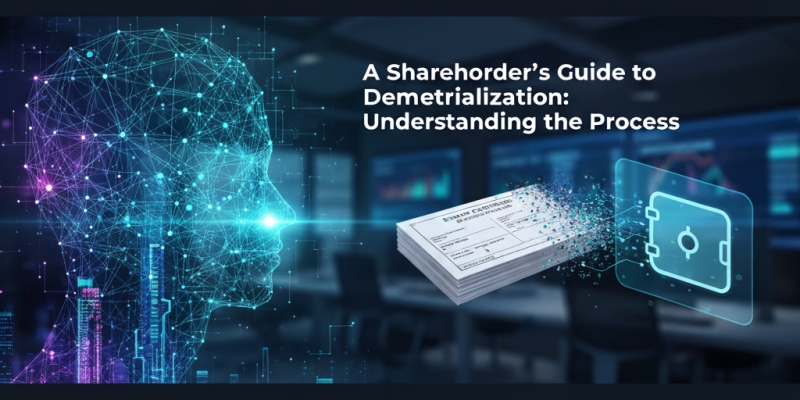In today’s digitized corporate landscape, physical share certificates are rapidly becoming a thing of the past. Driven by mandates from the Ministry of Corporate Affairs (MCA) and SEBI, dematerialization—the process of converting physical securities into an electronic format—is now essential for compliance, security, and efficient trading. For companies and shareholders alike, understanding this process is crucial.
This guide breaks down the dematerialization process step-by-step and clarifies key details to ensure a smooth transition from physical to electronic holdings.
The Key Players in the Demat Process
Before diving into the steps, it's important to know the parties involved:
Shareholder: The investor who holds the physical share certificates.
Depository Participant (DP): An agent of the depository (like a bank or broker) through which the shareholder opens and maintains a Demat account.
Depository: An institution like NSDL or CDSL that holds securities in electronic form on behalf of the investor.
Registrar and Transfer Agent (RTA): An intermediary like Nextgen RTA, appointed by the company to handle share registry, transfer, and dematerialization requests.
The 5-Step Dematerialization Process for Shareholders
As the process flow illustrates, dematerializing shares involves a clear, sequential journey. Here’s a detailed breakdown:
Step 1: Open a Demat Account with a Depository Participant (DP)
The first step for any shareholder is to open a Demat account with a DP. This account is similar to a bank account, but instead of holding money, it holds securities like shares and bonds in an electronic format.
Step 2: Submit a Demat Request Form (DRF)
The shareholder must fill out a Dematerialisation Request Form (DRF), which is provided by their DP. This form, along with the original physical share certificates, must be submitted to the DP. The shareholder should ensure they write "Surrendered for Dematerialisation" on each certificate.
Step 3: DP Forwards the Request to the Company or RTA
After receiving the documents, the DP verifies the details and forwards them for processing. It's important to note the specific routing: as per NSDL guidelines for unlisted shares, the DP sends the documents directly to the issuing company. The company will then forward the request to its RTA (like Nextgen RTA) for processing.
Step 4: RTA Processing and Intimation
The RTA receives the request from the company and checks the authenticity of the share certificates against its records. This is a critical step to prevent fraud. Once this check is complete, the RTA intimates the company and updates its system to confirm the validity of the request.
Step 5: Authorization and Credit of Shares
Following the RTA's processing, the dematerialization request is authorized with the depository. The depository then credits the equivalent number of shares to the shareholder's Demat account, and the RTA cancels the physical share certificates, completing the process.
What Forms Are Required?
The primary document for a shareholder to initiate this process is the Dematerialisation Request Form (DRF), which is provided by their Depository Participant (DP).
For companies, other forms such as the NSDL Corporate Action Form and CDSL Corporate Action Form are required for various corporate actions related to dematerialized securities.
You can find and download these and other important RTA forms directly from our website. Download here: https://www.nextgenregistry.com/rta-forms
Critical Points to Remember
Navigating the demat process involves a few nuances that every shareholder and company should be aware of:
Can a Shareholder have Multiple Demat Accounts?
Yes, an investor is free to open and maintain multiple Demat accounts with different DPs, just as one can have accounts with multiple banks.
The NSDL-CDSL Connection: A Crucial Detail
A common reason for the rejection of a demat request is a mismatch between depositories. A company obtains an ISIN for its shares from one of the two depositories in India: NSDL or CDSL. For a successful dematerialization, the shareholder’s Demat account must be with a DP registered under the same depository.
Example: If your company's ISIN is activated with NSDL, your shareholders must have a Demat account with an NSDL-affiliated DP. A request from a CDSL-only DP will not be processed.
How Do I Know Which Depository My Company is With?
If a shareholder is unsure, they can ask the company or its RTA. This simple query can prevent delays and rejections in the dematerialization process.
How Nextgen RTA Simplifies Dematerialization
The dematerialization process involves careful coordination between the shareholder, DP, company, and depository. Any discrepancy in documentation or procedure can lead to delays.
At Nextgen Share Registry Pvt Ltd, we act as the central coordinator to make this process seamless. We manage the entire backend workflow:
1). Verifying physical documents with precision.
2). Liaising directly with DPs and depositories (NSDL & CDSL).
3). Guiding companies and their shareholders on critical requirements, including the correct depository choice.
4). Ensuring quick and compliant processing of all dematerialization requests.
In an era of mandatory dematerialization, ensuring a hassle-free experience for your shareholders is key to building investor confidence. If your company needs expert assistance with dematerialization, ISIN generation, or other compliance needs, Nextgen RTA is here to provide end-to-end support.

